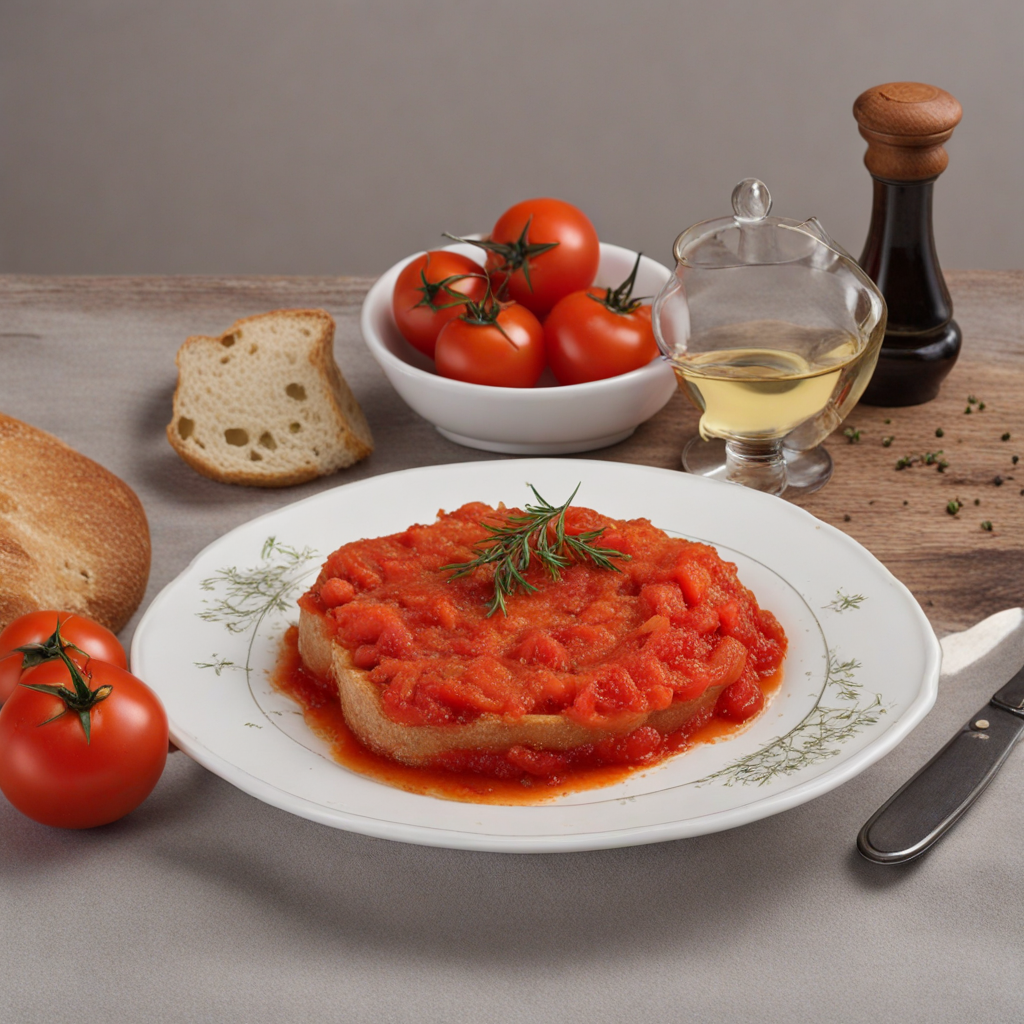Pa amb tomàquet
Pa amb tomàquet is a delightful dish hailing from the culinary traditions of Andorra, embodying the essence of simple yet robust flavors. At its core, this dish features rustic bread, typically a crusty country loaf, which is generously rubbed with ripe tomatoes. The tomatoes used are often juicy and flavorful, providing a fresh and vibrant taste that is complemented by the bread's chewy texture. The process of rubbing the tomato into the bread allows the juices and pulp to seep into the crust, creating a moist base that is bursting with flavor. To elevate the dish further, a drizzle of high-quality extra virgin olive oil is added, infusing the bread with rich, fruity notes that enhance the overall experience. A sprinkle of sea salt is often included, bringing out the natural sweetness of the tomato and adding a hint of contrast. This simple combination showcases the beauty of Mediterranean ingredients, highlighting their quality and freshness without overwhelming the palate. Pa amb tomàquet can be enjoyed in various ways, often served as an appetizer or a light snack, and is perfect for pairing with cured meats, cheeses, or a glass of local wine. Its versatility makes it a beloved staple in Andorra, where it embodies the comfort of home-cooked meals. The dish invites you to savor each bite slowly, as the harmonious blend of flavors transports you to the sun-soaked terraces of the Pyrenees, making it a must-try for anyone looking to explore the culinary treasures of this enchanting region.
How It Became This Dish
The History of Pa Amb Tomàquet: A Culinary Tradition from Andorra Nestled in the eastern Pyrenees mountains, between France and Spain, Andorra is a small principality with a rich cultural tapestry woven from its Catalan heritage and the influences of its neighbors. One of the culinary gems that has emerged from this mountainous enclave is Pa amb tomàquet, a simple yet delicious dish that has transcended its humble origins to become a symbol of Catalan cuisine, celebrated for its authenticity and rustic charm. #### Origins: A Rustic Staple Pa amb tomàquet, which translates to "bread with tomato," is a dish that epitomizes the Catalan ethos of making the most of humble ingredients. Its origins are often traced back to the rural communities of Catalonia, with variations found across the Pyrenees region, including Andorra. The dish likely emerged in the late 19th century when tomatoes, introduced to Europe from the Americas, became widely cultivated and integrated into local diets. The foundation of pa amb tomàquet is simple: rustic bread, typically a crusty loaf, is rubbed with ripe tomatoes and drizzled with olive oil. Salt is often added to enhance the flavors. This straightforward preparation reflects the agricultural lifestyle of the region, where fresh, local ingredients were paramount. The dish was favored by farmers and shepherds for its simplicity, providing sustenance after long days in the fields and mountains. #### Cultural Significance: More Than Just a Dish In Andorra and Catalonia, pa amb tomàquet is more than just a meal; it embodies a way of life. The practice of preparing and sharing this dish speaks to the communal spirit of the region. Traditionally, families would gather around the table, sharing stories and laughter over slices of bread topped with juicy tomatoes. The act of preparing the dish is as integral to its enjoyment as the consumption itself. Rubbing the tomato on the bread requires a certain rhythm and style—each person brings their own touch to the dish, creating a unique culinary expression. Pa amb tomàquet is also a reflection of the Catalan identity. As a dish associated with local cuisine, it carries a sense of pride and heritage. In a time of globalization where culinary traditions face dilution, pa amb tomàquet serves as a reminder of the importance of preserving local flavors and practices. It is often served in restaurants as an appetizer or tapa, showcasing its adaptability and enduring appeal. The cultural significance of pa amb tomàquet has only been amplified by movements to protect and promote Catalan cuisine. Culinary festivals and local markets across Andorra and Catalonia feature this dish prominently, celebrating its role in the region’s culinary landscape. Whether enjoyed in a rustic farmhouse or a contemporary eatery, pa amb tomàquet represents a connection to the land, the community, and the culinary traditions passed down through generations. #### Development Over Time: From Tradition to Modernity As with many traditional dishes, pa amb tomàquet has evolved over the years while retaining its core elements. In its earliest iterations, the dish utilized whatever type of bread was available, often a dense, country loaf. The advent of industrial baking has led to a variety of bread options, from artisanal sourdough to ciabatta, each lending a different texture and flavor profile to the dish. The way tomatoes are used has also seen innovation. While traditionally, a ripe, juicy tomato was simply cut in half and rubbed on the bread, modern interpretations allow for a range of tomatoes, including heirloom varieties that are rich in flavor. Some chefs experiment with slow-roasted tomatoes or even tomato confit, elevating the dish to new culinary heights while still honoring its rustic roots. Furthermore, while olive oil remains a staple, the use of flavored oils—such as those infused with garlic, herbs, or chili—has become popular. These variations add depth and complexity to the dish, allowing it to cater to contemporary palates while maintaining its original spirit. Pa amb tomàquet has also found its place in culinary fusion, with chefs around the world incorporating its elements into diverse cuisines. For instance, it can be found in Italian-inspired dishes or served as a bruschetta-style appetizer in various international restaurants. This globalization of pa amb tomàquet is a testament to its versatility and the universal appeal of its flavors. #### The Role of Pa Amb Tomàquet in Modern Andorran Life In modern Andorra, pa amb tomàquet continues to hold a special place in the hearts of locals and visitors alike. It is often featured in tapas bars and traditional restaurants, where it is served alongside cured meats, cheeses, and local wines. The dish is a staple at family gatherings and celebrations, reinforcing its status as a beloved comfort food. Additionally, the emphasis on local and sustainable ingredients has brought renewed interest to pa amb tomàquet. Many Andorran restaurants focus on sourcing tomatoes from local farms and using bread from regional bakeries, ensuring that the dish reflects the flavors of the land. This commitment to quality ingredients not only enhances the dish's flavor but also supports the local economy and fosters a deeper connection between food and place. In the realm of gastronomy, pa amb tomàquet has been celebrated by chefs and food enthusiasts alike for its simplicity and depth of flavor. Culinary competitions and food festivals often highlight this dish, allowing chefs to showcase their creativity while paying homage to traditional techniques. As a result, pa amb tomàquet has not only survived but thrived in the modern culinary landscape. #### Conclusion: A Timeless Classic Pa amb tomàquet is more than a mere dish; it is a celebration of Andorran and Catalan culture, a testament to the beauty of simplicity in cooking, and an enduring symbol of community and tradition. From its humble beginnings as a farmer's sustenance to its place on the menus of high-end restaurants, pa amb tomàquet has evolved while remaining deeply rooted in its origins. As Andorra continues to navigate the complexities of modernity, pa amb tomàquet will undoubtedly remain a cherished culinary tradition. It invites both locals and visitors to savor a slice of history with every bite, reminding us that some of the greatest culinary pleasures arise from the simplest of ingredients. In the heart of the Pyrenees, where the mountains stand as a backdrop to life’s unfolding stories, pa amb tomàquet serves as a delicious reminder of the enduring power of food to connect us to our past and to each other.
You may like
Discover local flavors from Andorra







